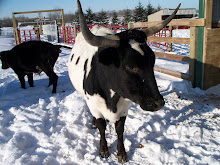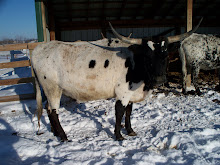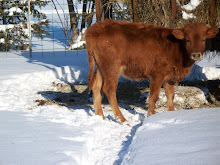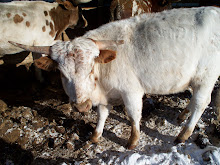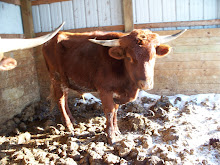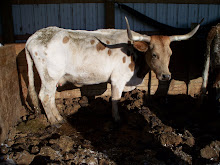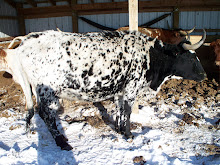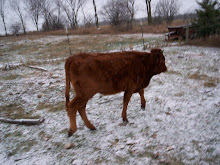Friday, December 19, 2008
TEXAS Longhorn Facts
A Texas longhorn steer
The Texas longhorn is a breed of cattle known for its characteristic horns, which can extend to 120 inches tip to tip for steers and exceptional cows and bulls in the 70 to 80 inch tip to tip range. Horns can have a slight upward turn at their tips or even triple twist. Texas Longhorns are known for their extreme diversified coloring. The Texas Longhorn Breeders Association of America and the International Texas Longhorn Association serve as the recognized registries for the breed. Texas Longhorns with elite genetics can often fetch up to $40,000 or more at auction with the record of $160,000 in recent history for a cow .[1] Due to their innate gentle dispositions and intelligence, Texas Longhorns are increasingly being trained as riding steers.
The Cattlemen’s Texas Longhorn Registry Certified Texas Longhorn Registry (CTLR), is the recognized breed registry dedicated to preserving the purest Texas Longhorn of foundation bloodlines. By incorporating the tools of visual inspection of cattle by the most knowledgeable of Texas Longhorn breeders and the use of bloodtype analysis to further identify any evidence of impurities and for future parentage identification, CTLR rekindled the ideal of preserving for posterity fullblood Texas Longhorn cattle.
[ History of the breed
A Texas longhorn cow
The first cattle to set foot in North America and the only breed of cattle to evolve without human management, the Texas Longhorn can thrive in country where no other breed can live; subsist on weeds, cactus and brush; range days away from water; and stay fit and fertile whether it’s living in the scorching, parasite-infested tropics or in the arid, subzero winters of Montana.[3]
The leaner longhorn beef was not as attractive in an era where tallow was highly prized, and the longhorn's ability to survive on often poor vegetation of the open range was no longer as much of an issue. Other breeds demonstrated traits more highly valued by the modern rancher, such as the ability to put on weight quickly. The Texas longhorn stock slowly dwindled, until in 1927 the breed was saved from almost certain extinction by enthusiasts from the United States Forest Service, who collected a small herd of stock to breed on a refuge in Oklahoma. A few years later, J. Frank Dobie and others gathered small herds to keep in Texas state parks. They were cared for largely as curiosities, but the stock's longevity, resistance to disease and ability to thrive on marginal pastures quickly revived the breed as beef stock. Today, the breed is still used as a beef stock, though many Texas ranchers keep herds purely because of their link to Texas history.
In other parts of North America this breed is used for much more. Longhorn cattle have a strong survival instinct and can find food and shelter during times of rough weather. Longhorn calves are very tough and can stand up sooner after birth than other breeds. Longhorn cattle can breed for a long time, well into their teens. There have been cows that have bred for up to thirty years. Some ranchers keep Longhorns for their easy calving. A Longhorn cow will often go off on her own to a safe place to have the calf then bring it home. They are also known to hide their calves in safe places to avoid predation, sometimes causing difficulty for ranchers, who may need to work on the animal.
Most breeds of cattle fall into either beef or dairy. The Texas longhorn is a beef animal and is known for its lean beef, which is lower in fat, cholesterol and calories than most beef. The Texas Longhorns are also used for their many excellent qualities adding hybrid vigor and easy calving abilities when crossed with other breeds. However, they continue to represent the romance of the Old West and are often retained for their beauty and intelligence.
The Texas longhorn's coat shows a wide variation in color
One current trend for Texas Longhorn breeders (owners) is to breed for horn characteristics. Due to the variation in horn growth, with some cattle having almost flat horns while others have many twists and turns, there are three horn measurements that can be taken:
Tip to Tip - The length from each tip of the horn, a straight line. This is a common measurement.
Total Horn - The total length following the horn and always greater than the Tip to Tip
Base (or Poll) - The circumference of the horn at the largest point.
These measurements can be adjusted to a Horns per Month of Age (HMA) which is calculated by dividing the number of months of age into the horn measurement. For example, a 48 month old animal with 50" of horn would be 50 / 48 or 1.04" per month of age.
It is not uncommon for commercial ranchers to cross breed longhorns with other breeds, thus increasing hybrid vigor and easy calving characteristics. This is especially true in warmer climates where purebred longhorn cattle excel in this environment.
western wear

Sheplers proudly carries some of the world's best known brands: from Wrangler, Levi and Cinch to Justin, Lucchese, Ariat and Nocona, to Stetson to Carhartt and Montana Silversmiths, and much more all under one roof Widely known for its outstanding customer service, Sheplers was recently rated as one of the top ten of all catalogs in terms of customer satisfaction in the US.
Sheplers, since 1899, and still going strong
Sheplers, since 1899, and still going strong
Subscribe to:
Comments (Atom)
